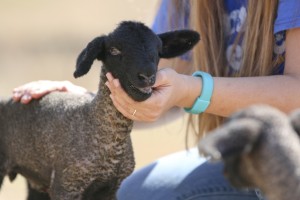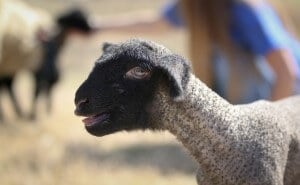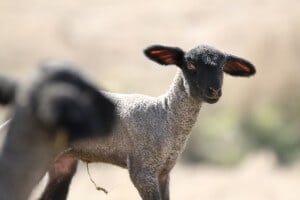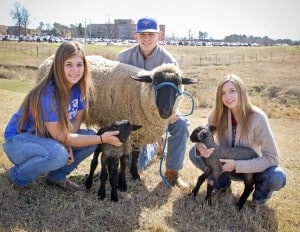
The first set of ewe twins were born in a blue barn on SAU’s farm on February 10, and over the Valentine weekend another set of twins and a group of triplets arrived. These babies marked an end to the silence of the lambs’ production that stopped more than 12 years ago, according to SAU Director of Farm Operations Rusty Hayes.
One might fall asleep in trying to count the many benefits these sheep could provide to agriculture education in the region. Hayes said foremost that each spring’s ewes will open the door for young FFA members to be involved in showing livestock, who may otherwise had been financially restricted. The female newborns, he said, may be loaned out for a season of showing before being returned for the next year’s breeding at SAU’s farm. The males will be offered for sale at a fraction of the typical price-tag that ranges between $1,200-1,500 for a competitive show lamb.

Then there’s the long hours of experiential learning gained from the student workers who care for the sheep and newborn ewes. SAU Associate Dean of Enrollment Services Shelly (Bussey) Whaley was the SAU student farm manager of sheep operations from 1992-94. She recently visited the lamb barn and shared some of her history with a current student worker of the growing sheep herd.

Whaley said she is thankful for the influence of Megan Maye McCurdy, assistant director of development at SAU, for being instrumental in getting the sheep operation back at SAU.
McCurdy grew up on a sheep farm, Maye Club Lambs, in Hatfield, Arkansas. She chose to come to SAU, and soon earned the prestigious role as the athletic mascot and University representative, the Mulerider. After she earned her degree, she was hired as the director of Story Arena before she moved into her current role aiding in SAU’s philanthropic endeavors. She and Hayes began discussing in 2014 the endless opportunities of brining sheep production back to campus. McCurdy’s father, also an SAU alum, provided SAU’s first six sheep in October of that year and has served as a mentor to the student workers. A ram, “Showtime,” was purchased in the summer of 2015.
McCurdy and Whaley both give a lot of credit to the hard work of junior Animal Science major Chase McCormick of Mena. He has been with the initiative from the beginning, said McCurdy, and has made a lot of sacrifices for the well-being of the sheep not only throughout the school year, but also during breaks between semesters. Other student workers include freshmen Jessica Hipp, Agriculture Business major from Mineral Springs, and Jessica Singleton, Agriculture Education major from Mena.
Whaley, who has been a part of SAU’s admissions team that has played a major role in SAU becoming Arkansas’ fastest growing university, could not help but recognize the benefits for current students and the attraction for prospective students.
“We have many agriculture students that will benefit from the experience of working with the sheep in their degree programs at SAU. This will also be an attraction for students that have a background in working with sheep. I am so excited to see the sheep operation back at SAU!”

